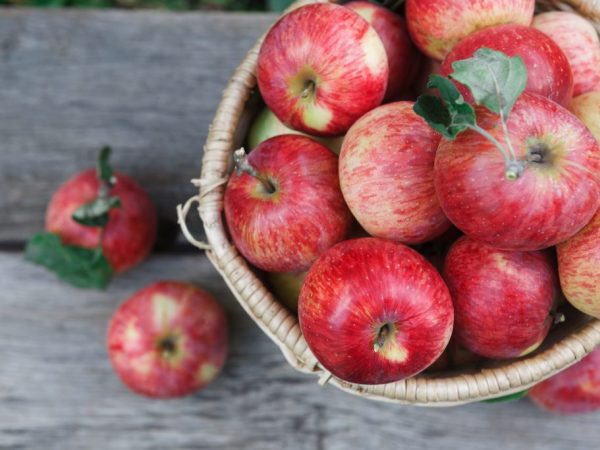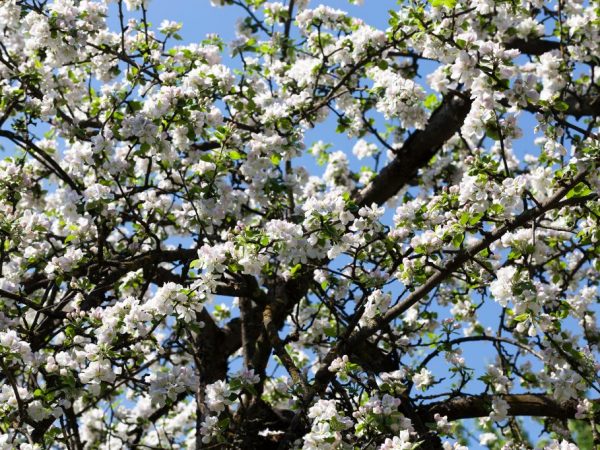Apple Growing Freshness
Apple tree Freshness was bred in 1976 at the Research Institute for Breeding Fruit Crops, Oryol Region, as a result of crossing Antonovka Red Barrel and Welsey. In most cases, these trees are undemanding to care for and give good yields.
- Characteristics of the variety
- Description of the tree and fruit
- Taste
- Yield
- Winter hardiness
- Disease and pest resistance
- Tree lifespan
- Landing
- Landing dates
- Landing technology
- Care
- Watering
- Fertilizer
- Pruning
- Tree protection
- Features of ripening and fruiting
- Harvesting and storage
- Subspecies and variants
- Gardeners reviews

Apple Growing Freshness
Characteristics of the variety
Belongs to the autumn varieties of universal use and is recommended for cultivation in intensive gardens.
Description of the tree and fruit
The height of the apple tree is 3-4 m, the crown is round, compact, medium thickened.
The skeletal branches are vertical and slightly curved. Their bark is smooth, brown. The rest are brown, of medium thickness, with well-pubescent tops.
Leaves are large, wide, oval, deep dark green, slightly curved, edges with small serrations.
The upper part of the leaf plate is glossy, with pronounced veins. The bottom is pale green, fleecy.
The apples are large enough (110-150 g), barrel-shaped. They are yellow-green in color, with intense red strokes all over the surface. The peel is glossy, oily.
Taste
Apples Fresh taste sweet and sour. The pulp is juicy, fine-grained, dense, with a greenish tint.
Tasting score: 4.2 (out of 5).
Due to the high pectin content, they are ideal for making jelly, jam, jam, mousse.
Yield
The tree begins to bear fruit 3-4 years after planting. In years with warm summers, up to 50-60 kg of crops are harvested from one apple tree.
Winter hardiness
The variety perfectly adapts to any climatic conditions, has excellent frost resistance and quickly adapts to sudden temperature changes.
Disease and pest resistance
High resistance to major diseases (scab and fungus) is the main advantage of the variety.
Infection with diseases such as black cancer and fire blight is possible.
For the prevention of black cancer, timely application of potash fertilizers is necessary, most often it develops on young seedlings.
A bacterial burn appears due to improper care. The only way to combat it is to destroy the source of infection.
Damage by some pests is possible:
- apple moth - use a solution of Chlorophos (according to the instructions);
- leaf roll - treatment with Nitrofen solution is recommended (according to the instructions);
- green aphid - processing of a tree with dandelion infusion will help (400 g of fresh leaves or 300 g of crushed roots, pour 10 liters of warm water and insist for 2 hours, strain and immediately spray the trees, it is applied twice a season - when the buds bloom after and after flowering);
- apple blossom beetle - to avoid the appearance, treatment is carried out with a solution of Karbofos (use according to the instructions).
Tree lifespan

With good care, a tree can live for over 60 years
The tree can live and bear fruit for approximately 60 years. If you regularly rejuvenate the shoots, the lifespan can be extended.
Landing
Apple variety Freshness perfectly takes root on any soil, but grows better on black earth, loamy and sandy loam.
It is necessary to choose a bright place, not far from other apple trees (this condition must be observed, since the variety is considered cross-pollinated), with deep groundwater. Otherwise, rotting of the root system is possible, which will lead to the premature death of the tree.
For planting, it is better to choose a two-year-old seedling with a well-developed, open root system.
Landing dates
The most optimal time for planting is the end of April. Planting a tree in the fall is undesirable, but possible.
When choosing the planting time, be guided by the temperature regime and the condition of the seedling. The tree should have time to take root.
Landing technology
3-4 weeks before planting, you need to dig a hole: depth - 60 - 70 cm, width - about 1 m.
Loosen the bottom well, make drainage from expanded clay or crushed stone, mix 8-10 kg of compost or humus with a bucket of earth (top layer), pour the mixture into the hole, cover it with foil and leave until planting.
We start planting a seedling:
- a prepared peg is driven into the center of the hole in advance;
- carefully place the seedling in the center of the pit, evenly spread the roots;
- cover half of the pit with earth, tamp the soil;
- fill in the rest of the pit, while making sure that the root collar is 5 cm above the surface;
- compact the soil and water the seedling abundantly.
For better survival, it is recommended to spray with Zircon or Epin once a week (dissolve 1 ampoule in 5 liters of water).
Care
Watering
The tree can survive severe drought with good irrigation.
Watering should be regular and abundant. Under normal conditions, young trees require 20 liters of water twice a week.
Fertilizer

The tree is fertilized twice a year
Top dressing begins from the 3rd year of the tree's life.
In the spring, organic fertilizers are applied (500 g of urea), and in the fall, they are scattered around the tree and slightly deepened by loosening mineral fertilizers (0.5 kg of nitrophoska and 50 g of sodium guamate).
Before flowering and at the stage of fruit formation, phosphorus-potassium (350 g of potassium and 350 g of superphosphate) are applied.
Pruning
The procedure is carried out for the first time 3 years after planting, in the spring, after the threat of frost has passed. Diseased, damaged and old branches are removed.
In the fall, it is undesirable to carry out pruning.
To form a crown, you must:
- cut off last year's shoots by 1⁄4;
- shorten the lateral branches to 3-4 buds;
- cut out completely curved, dried out, growing in the middle of the shoots.
Tree protection
To protect the bark from cracking and rodents in the fall, and then again in February, the stem is whitewashed (the description of the use of the drug in the instructions). In winter, they throw snow into the near-stem circle and trample it down.
Features of ripening and fruiting
Freshness belongs to early-growing apple varieties. Begins flowering in July, and fruits ripen in the second half of September (for 1-2 weeks).
Ripe fruits do not crumble. Fruiting is annual, but this indicator decreases with age.
Harvesting and storage
Harvesting takes place in the third decade of September. Picking apples should be on a warm, dry day, in the afternoon. First, cut off from the southern side, from the lower branches, gradually moving to the top.
When stored properly, in a dark and cool place, apple harvest Freshness can be stored until late spring.
Subspecies and variants
Two varieties of this variety are common among gardeners.
- Grown on a columnar rootstock. This subspecies is used in industrial gardens. Fruiting times remain the same, but the advantage is a compact appearance and the possibility of a compacted planting.
- Grafted onto a dwarf stock. Has a neat crown and not a tall trunk.The root system is more developed, so it can be grown in areas with higher groundwater levels. Yields are high, but life expectancy is shorter.
Gardeners reviews
The Svezhest variety is happily grown both in gardens on private plots and on industrial farms.
Delicious and sweet apples delight with their taste and provide an opportunity to receive vitamins all winter. The tree is unpretentious to care for, so even a beginner can grow it.

